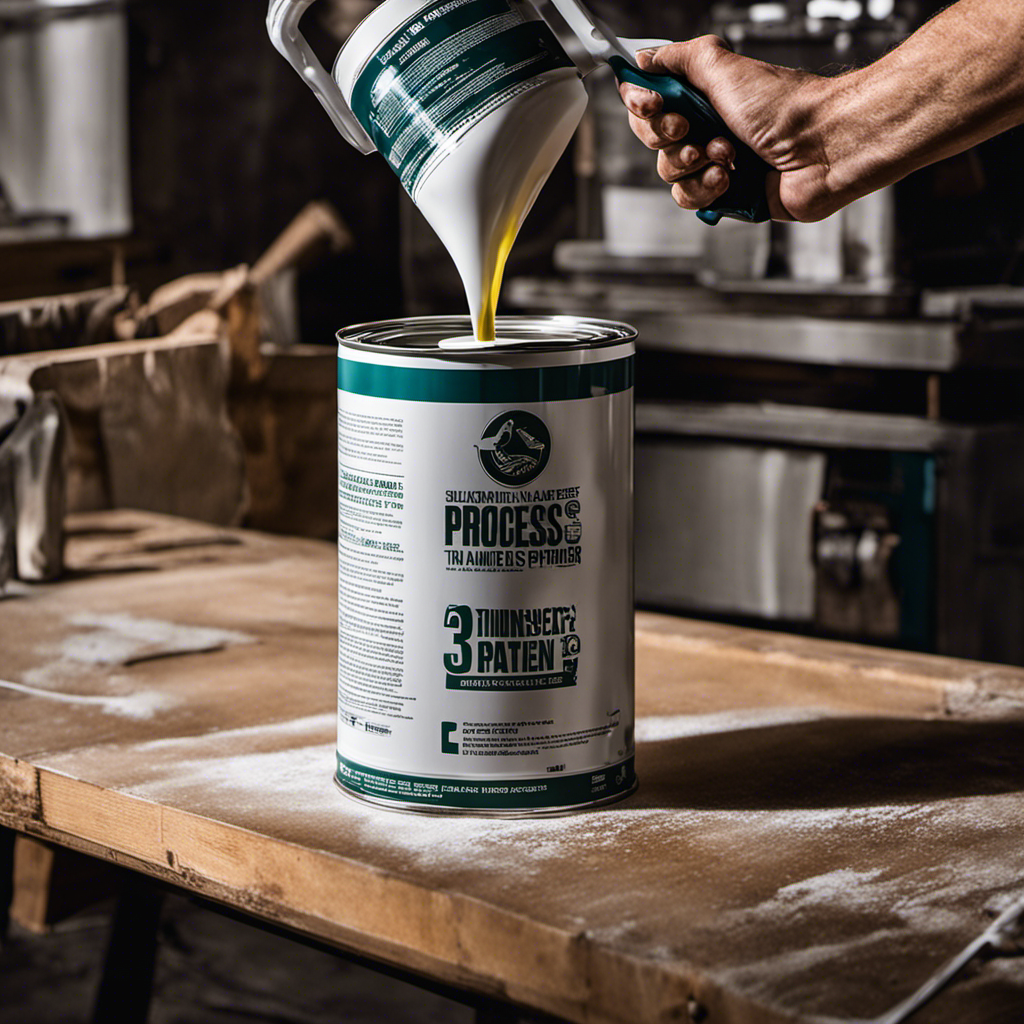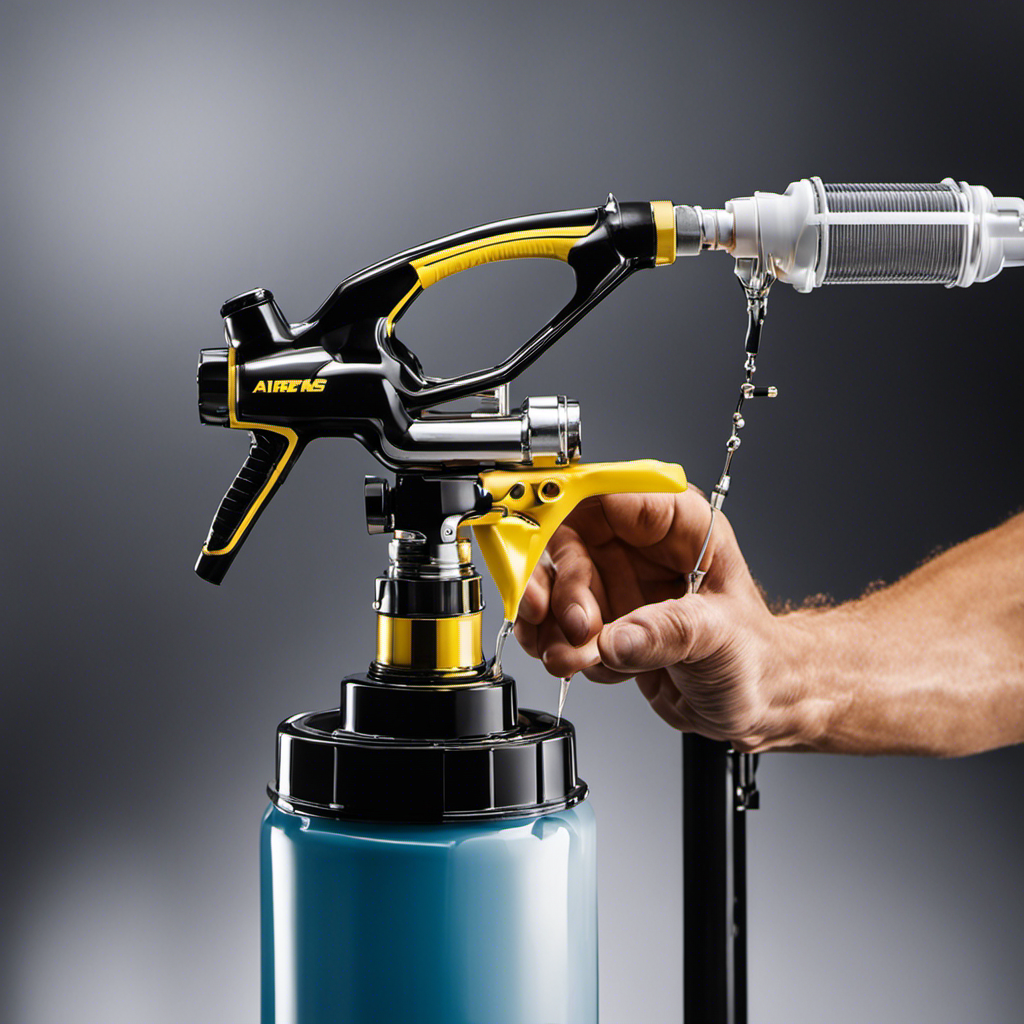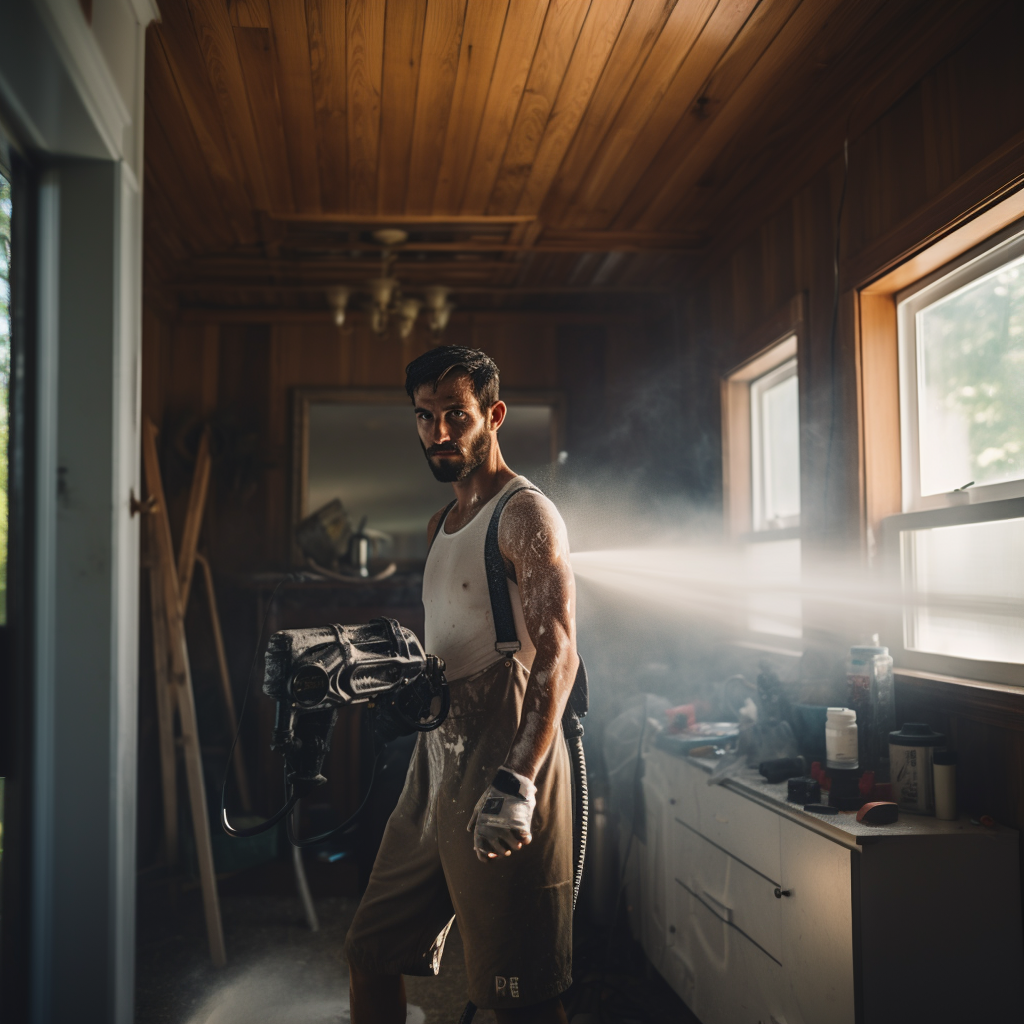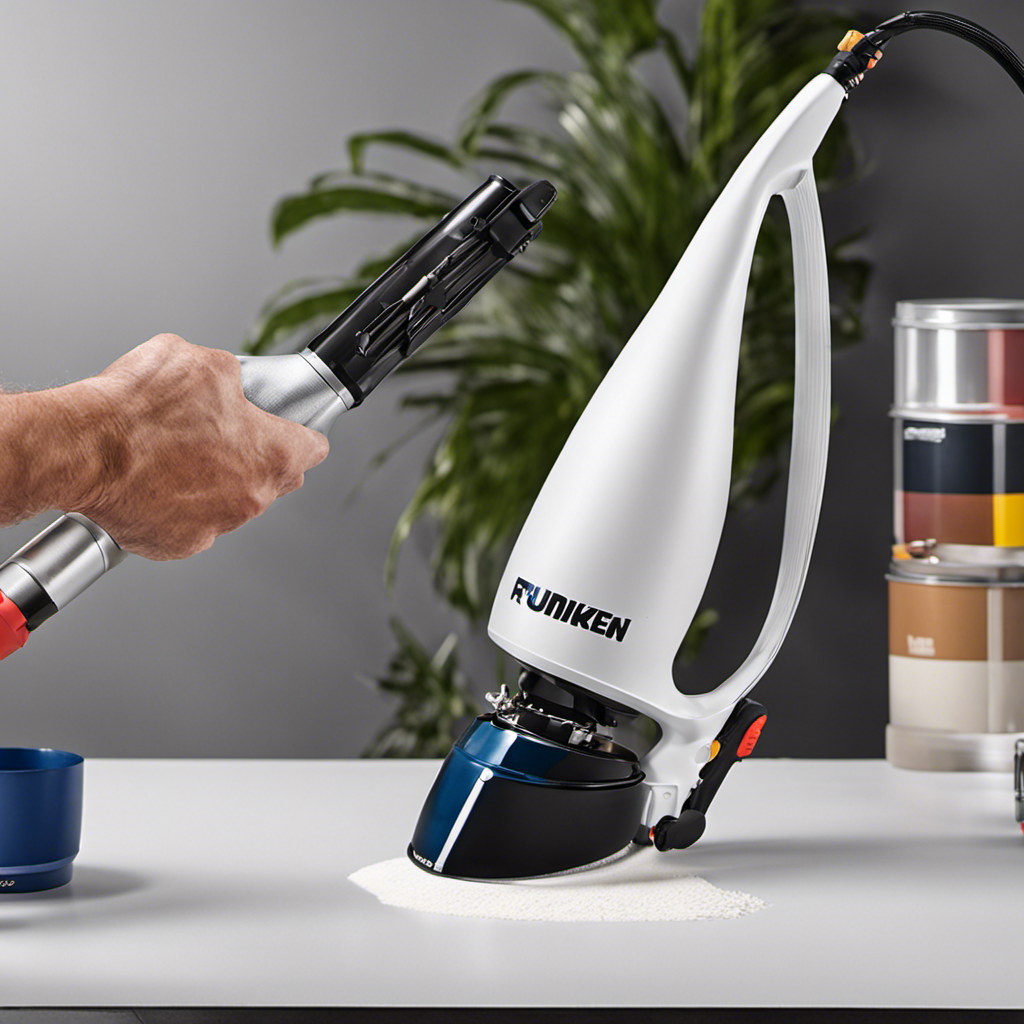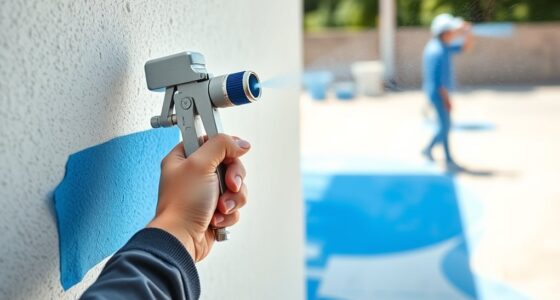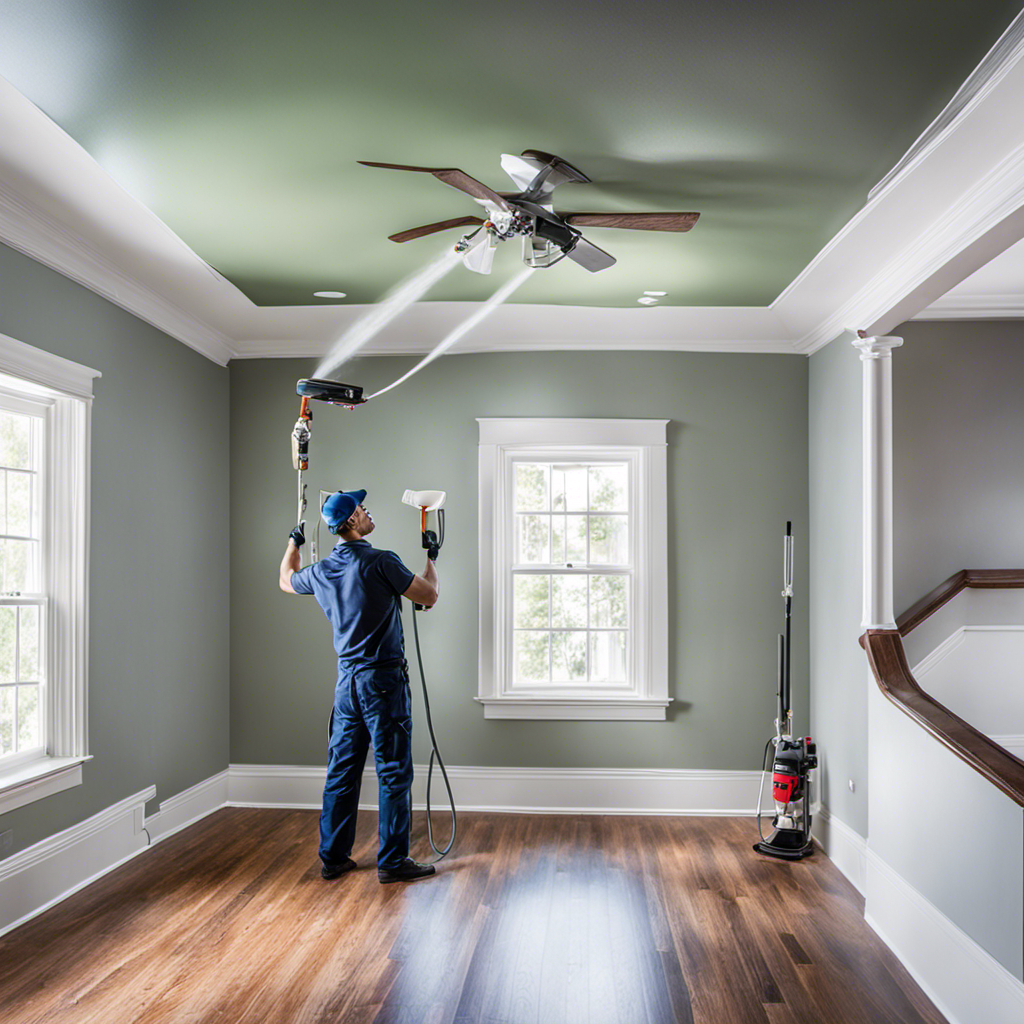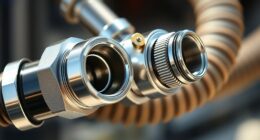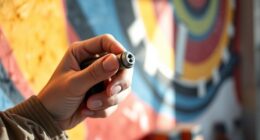Thinning latex paint for use with an airless sprayer may seem challenging, but it is an important step in obtaining a smooth, high-quality finish.
Did you know that using the right technique can make a significant difference in the outcome of your painting project? By carefully measuring and gradually adding small amounts of water or latex paint thinner, you can ensure optimal consistency and coverage.
In this article, we will explore the proper techniques, maintenance tips, and safety precautions for thinning latex paint for airless sprayers.
Key Takeaways
- Thin paint in small batches to maintain control over consistency.
- Gradually add small amounts of water or latex paint thinner to the paint while stirring continuously.
- Test the thinned paint on a scrap surface or cardboard to ensure it sprays evenly and covers well.
- Choose the right nozzle size for better atomization and even coverage when spraying thinned latex paint.
Thinning Techniques for Latex Paint
The painter should gradually add small amounts of water or latex paint thinner to the paint while stirring continuously in order to achieve the desired consistency when thinning latex paint for an airless sprayer.
The consistency of the paint is crucial for achieving optimal spray coverage. By adding water or latex paint thinner in small increments, the painter can control the thickness of the paint and ensure it is suitable for spraying.
Stirring the paint continuously during the thinning process helps to evenly distribute the added liquid and maintain a consistent consistency.
This attention to detail in thinning the paint will result in better spray coverage, as the paint will be able to flow smoothly through the sprayer and evenly coat the surface being painted.
Proper Mixing and Measurement
To ensure optimal results, painters should carefully measure and mix the appropriate amount of paint before adding any thinning agents. This step is crucial in achieving the desired paint consistency and ensuring proper thinning ratio. Here are some key points to consider:
-
Accurate Measurement: Painters should measure the required amount of paint for the project and pour it into a separate container before thinning.
-
Gradual Thinning: When adding water or latex paint thinner, it is important to do so gradually while stirring continuously. This helps maintain control over the consistency of the paint.
-
Testing the Thinned Paint: Before spraying the thinned paint, it is recommended to test it on a scrap surface or cardboard to ensure it sprays evenly and covers well.
-
Avoiding Excessive Thinning: It is crucial to avoid excessive thinning to prevent waste and achieve the desired finish. Proper technique includes measuring the amount of paint, pouring it into a separate container, and gradually adding the appropriate thinning agent.
Alternative Thinning Agents
Using alternative thinning agents, such as commercial latex paint thinners or Floetrol, can provide painters with more options for achieving the desired paint consistency. These alternative thinners can be used instead of water to thin latex paint for an airless sprayer.
Commercial latex paint thinners are specifically designed to thin latex paint and maintain its properties. Floetrol, on the other hand, is a paint conditioner that can enhance the flow of the paint and improve its leveling and adhesion.
When using alternative thinners, it is important to consider the shelf life of the thinned latex paint. Properly stored, thinned latex paint can have a shelf life of up to a year. This allows painters to prepare larger batches of thinned paint in advance, saving time and ensuring consistent results throughout their projects.
Cleaning and Maintenance of Airless Sprayer
After each use, painters should clean the airless sprayer thoroughly to prevent clogs and ensure optimal painting performance. To troubleshoot any issues with the sprayer, it is important to use the best cleaning solvents.
Here are four recommended cleaning solvents for airless sprayers:
-
Mineral Spirits: This solvent is effective in removing oil-based paints and varnishes from the sprayer components. It is important to use it in a well-ventilated area and follow safety precautions.
-
Denatured Alcohol: This solvent is suitable for cleaning water-based paints and stains. It evaporates quickly and leaves no residue, making it ideal for sprayer maintenance.
-
Acetone: Acetone is a powerful solvent that can remove stubborn paint residues. However, it should be used with caution as it is highly flammable and can damage certain plastic components of the sprayer.
-
Warm Soapy Water: For general cleaning and maintenance, warm soapy water can be used. It is safe and effective in removing water-based paints and debris from the sprayer.
Safety Precautions and Nozzle Efficiency
Wearing the proper safety gear, such as goggles, gloves, and a respirator mask, is essential to ensure the safety of the painter while using an airless sprayer. The respirator mask provides protection against harmful fumes and particles in the air, preventing respiratory issues.
Additionally, selecting the appropriate nozzle size for the airless sprayer is crucial for efficient and effective paint application. A smaller nozzle size is ideal for thinning out latex paint, as it allows for better atomization and more even coverage.
Regularly cleaning the nozzle is also essential to maintain its efficiency and prevent clogs.
Frequently Asked Questions
Can I Use Water as a Thinning Agent for Latex Paint in an Airless Sprayer?
Water can be used as a thinning agent for latex paint in an airless sprayer, but there are alternative thinning agents that may yield better results.
Using additives like commercial latex paint thinners or Floetrol can help achieve the desired consistency and enhance the performance of the paint.
It is important to follow best practices for thinning latex paint, such as measuring the amount of paint, gradually adding the thinning agent, and thoroughly mixing to prevent clogging or spitting in the sprayer.
What Is the Shelf Life of Thinned Latex Paint When Stored Properly?
The shelf life of thinned latex paint, when stored properly, can last up to a year. Proper storage techniques include sealing the container tightly to prevent air exposure, storing it in a cool and dry place, and avoiding extreme temperatures.
It is important to note that the shelf life can vary depending on the specific brand and type of paint. Regularly checking for any signs of spoilage, such as an unpleasant odor or clumps, is recommended before using thinned latex paint.
How Often Should I Clean the Nozzle of My Airless Sprayer for Optimal Efficiency?
Cleaning frequency is an important factor in maintaining optimal nozzle efficiency for an airless sprayer. Regular cleaning is recommended to prevent clogs and ensure efficient paint application.
The frequency of cleaning depends on the frequency of use and the type of paint being sprayed. However, as a general guideline, it is recommended to clean the nozzle thoroughly after each use. This will help to remove any paint residue or build-up, ensuring that the sprayer operates at its best efficiency.
Are There Any Specific Safety Precautions I Should Take When Using an Airless Sprayer to Spray Latex Paint?
When using an airless sprayer to spray latex paint, there are specific safety precautions one should take.
It is important to prioritize safety for a successful paint job. The painter should wear proper safety gear such as goggles, gloves, and a respirator mask.
Additionally, working in a well-ventilated area is crucial to reduce inhalation risks. Opening windows or using fans to circulate fresh air can help ensure proper ventilation.
Taking these safety precautions will help minimize any potential risks associated with spraying latex paint.
Can I Use Any Type of Latex Paint for an Airless Sprayer, or Does It Need to Be Specifically Formulated for Airless Sprayers?
When using an airless sprayer, it is recommended to use latex paint that is specifically formulated for airless sprayers. These paints are designed to have the right viscosity for optimal performance.
However, some other types of latex paint can also be used with proper thinning techniques. It is important to choose high-quality latex paint brands for airless sprayers to ensure good coverage and durability.
Thinning techniques should be followed carefully to achieve the desired consistency and prevent clogging in the sprayer.
Conclusion
In conclusion, thinning latex paint for an airless sprayer requires finesse and focus. By following the proper techniques and using the right tools, one can achieve a flawless finish.
Careful consideration of consistency and measurement, along with gradual additions of water or latex paint thinner, will yield the desired results. Don’t forget to test the paint’s viscosity and strive for even coverage.
Clean and maintain your airless sprayer regularly to prevent clogs and ensure efficiency. Lastly, prioritize safety and nozzle efficiency for a successful painting experience.
With these tips in mind, you’ll be a pro at thinning latex paint in no time!
Franz came aboard the Paint Sprayer Zone team with a background in both journalism and home renovation. His articulate writing style, combined with a passion for DIY projects, makes him an invaluable asset. Franz has a knack for breaking down technical jargon into easy-to-understand content, ensuring that even the most novice of readers can grasp the complexities of paint sprayers.
